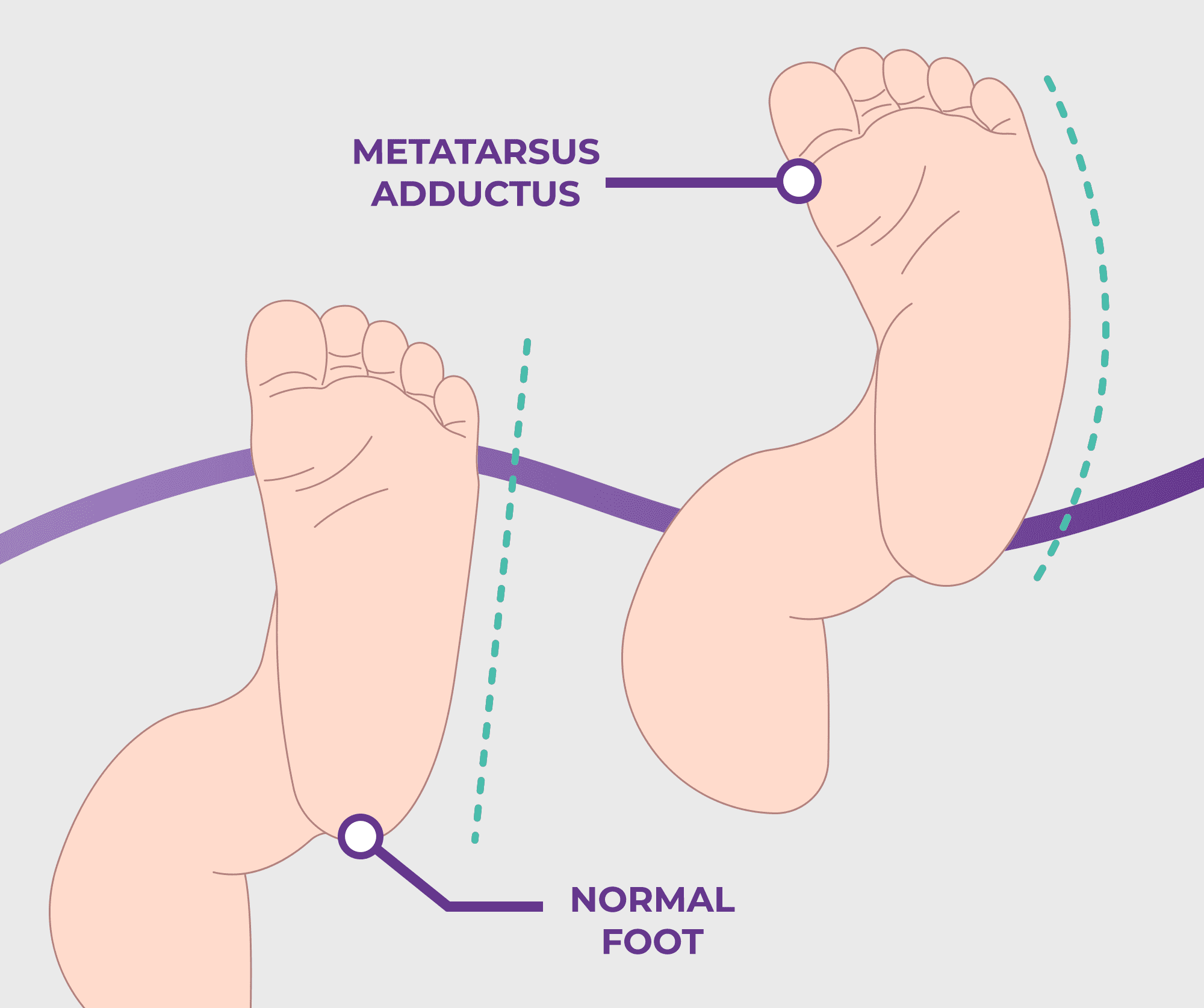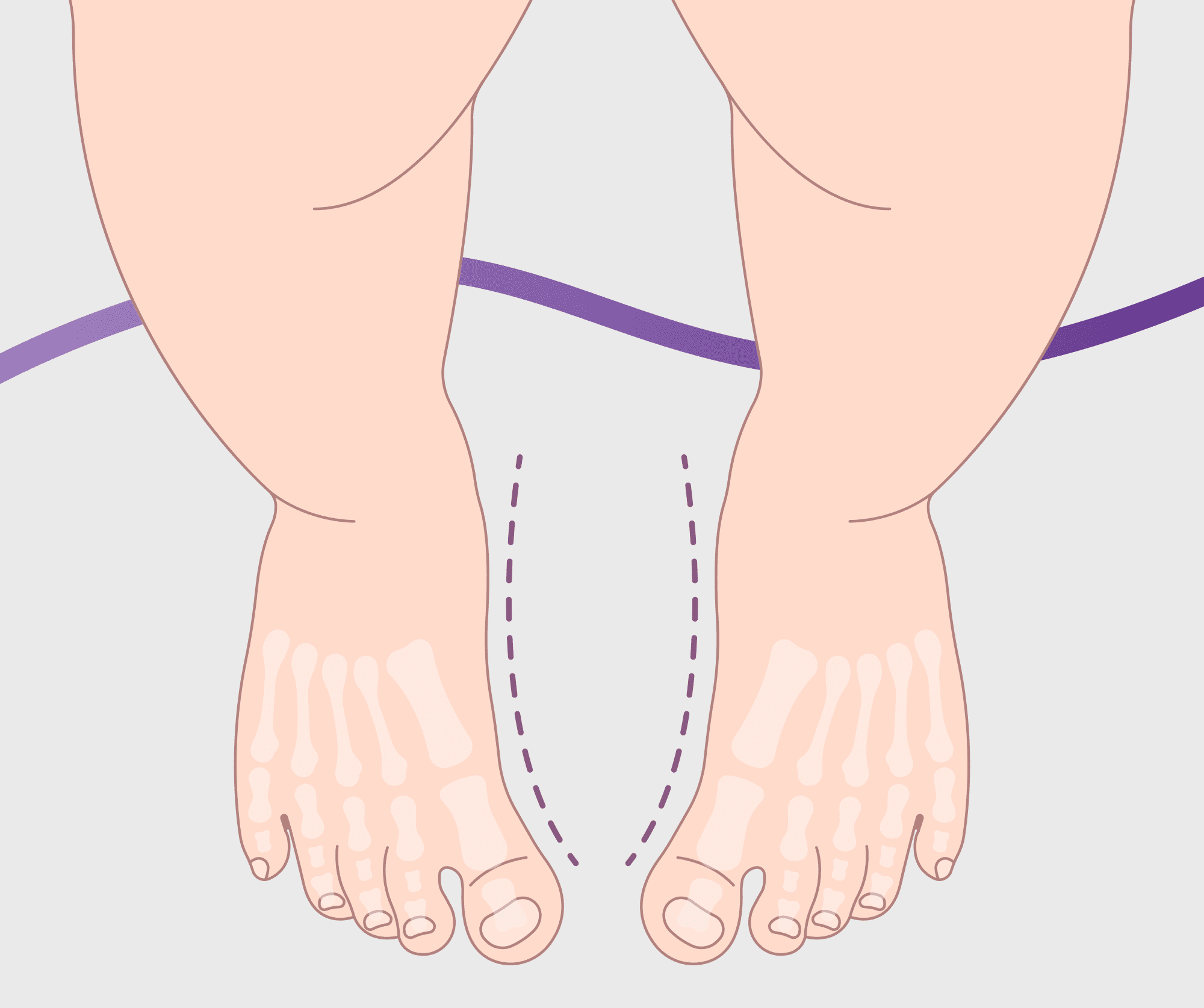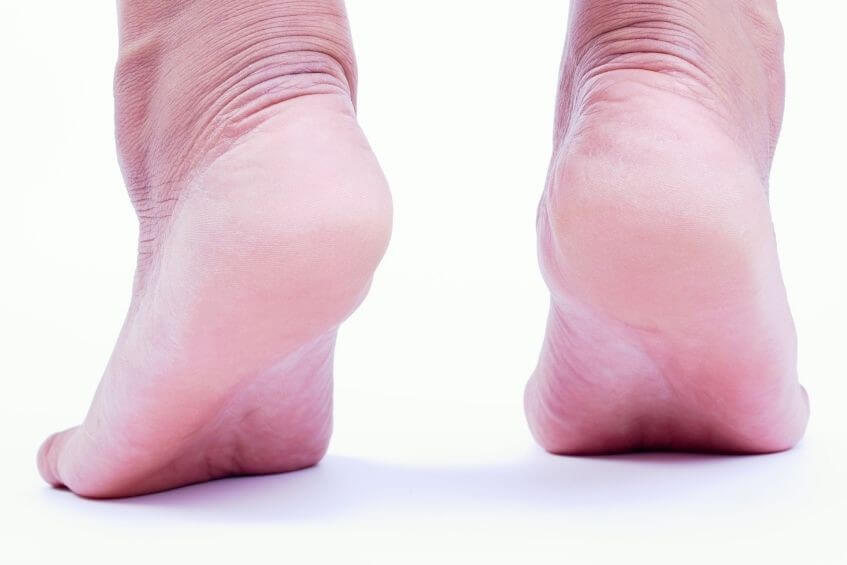
Jump to section
Metatarsus adductus is a congenital condition that is present at birth where the ends of one or both feet curve inwards like a ‘C’ shape. It is very concerning for new parents, who fear for their child’s ability to walk normally and meet developmental milestones, but can often be treated with simple techniques with the help of your podiatrist.

Looking at the name metatarsus adductus, it translates to mean metatarsals (the long bones of the foot) that have adducted (turned
in towards the midline of the body). The result is a visibly curved shape of the forefoot.
Metatarsus adductus can be classed as either flexible, meaning that the foot can be temporarily straightened when
manipulated by hand, or non-flexible, where the structure of the foot is more rigid and can’t be straightened with
the hand. Most cases of metatarsus adductus are flexible.
While some do refer to this condition as clubfoot, this isn’t technically accurate as clubfoot involves the C-shaped curvature of the entire foot starting with the heel, whereas in metatarsus adductus it is only the forefoot that curves inwards relative to the rearfoot. This means that treatment for metatarsus adductus is often simpler and less extensive.
Metatarsus adductus is usually detected and diagnosed at birth, with the position of the growing baby’s foot in the womb being linked as a causative factor. At times, metatarsus adductus can be missed at birth, and parents may instead notice that their child appears to be in-toeing.
Aside from the curved or ‘banana-shaped’ position of the foot, you may also notice:

There is no consensus or distinct cause for metatarsus adductus, but is often thought to be linked to the baby’s position in the womb. This theory is reinforced by an increased likelihood of metatarsus adductus in first pregnancies, twin pregnancies, late pregnancies and for pregnancies with reduced quantities of amniotic fluid surrounding the baby, all of which can reduce the space available for the growing baby and may hold their feet in tighter positions that may lead to metatarsus adductus.
Metatarsus adductus can usually be diagnosed through a physical exam alone due to the distinct clinical features. Your practitioner may look
at a bisection line of the heel - a line which when drawn from the centre of the heel would exit the forefoot between the second and third
toes, but in metatarsus adductus, would exit more towards the end of the foot (closer to the fifth toe). The ‘V’ finger test can
also be used, where the heel is cupped inside the ‘V’ formed by the index and middle fingers, and a curve at the midfoot away
from the middle finger may indicate metatarsus adductus.

X-rays can also be done to diagnose and track the progress of metatarsus adductus, but are often not needed.
Yes, and the prognosis is very good. Studies show that of the cases identified at birth, 85% to 90% resolve by 12 months of age. Here at The Feet People, our goal is to give all parents the reassurance and care that their children deserve when it comes to their foot health. This is why we:
Treating metatarsus adductus depends on how severe the deformity is, and whether it is flexible or rigid. In some cases, where the clinical signs indicate that it is likely to resolve on its own, we will book regular monitoring appointments to ensure that we’re seeing good progress and intervene if anything unexpected arises. When treatment is indicated, it may involve:
While many parents manage their baby’s metatarsus adductus with no intervention other than regular monitoring over their first year of life, those that do so have the all-clear for their doctor or podiatrist after an examination to ensure that they meet the criteria for those whose feet are likely to self-straighten, and also where other associated problems like hip dysplasia have been ruled out.
Leaving metatarsus adductus untreated when the problem is unlikely to correct itself may have long standing consequences for your child including problems with their gait, regular tripping in falling, difficulty playing sports and keeping up with their friends, and more.
As there is no distinct cause of metatarsus adductus, there are no proven prevention strategies. Our best advice is that if it is picked up at birth, to have it assessed by a podiatrist early, so treatment can be implemented early if needed. Additionally, if no metatarsus adductus has been noted, but you notice some in-toeing and are concerned, to always bring your child in for an assessment.

Our feet are the foundation for the entire body, so it's important that they have enough strength to tolerate our activity levels. Use
these three exercises to help strengthen your feet.

Not everyone needs orthotics, but they can play an integral role in treating or relieving pain in several foot and lower limb conditions.

The heat and humidity of an Australian summer makes it a prime time for issues to arise, so our newest podiatrist Lucy has put together
seven helpful tips to keep your feet healthy and problem free throughout summer.
| Monday | 7:40am - 6:00pm |
| Tuesday | 7:40am - 6:00pm |
| Wednesday | 7:40am - 6:00pm |
| Thursday |
7:40am - 6:00pm |
| Friday | TEMP CLOSED |
| Saturday | CLOSED |
| Sunday | CLOSED |
Ground Floor, 344 Queen Street,
Brisbane City QLD 4000
| Monday | 7:40am - 6:00pm |
| Tuesday | 7:40am - 6:00pm |
| Wednesday | 7:40am - 6:00pm |
| Thursday |
7:40am - 6:30pm |
| Friday | 7:40am - 5:00pm |
| Saturday | 7:40am - 4:30pm |
| Sunday | CLOSED |
Newmarket Village, 114/400 Newmarket Rd, Newmarket QLD 4051